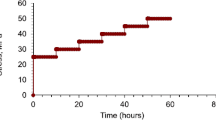Reliable accelerated testing routines involving tests at enhanced temperatures are of paramount importance in developing viscoelastic models for polymers. The theoretical basis, the time-temperature superposition (TTS) principle, is used to construct master curves and temperature-dependent shift factor, which is the necessary information to simulate the material response in arbitrary temperature and strain regimes. The Dynamic Mechanical and Thermal Analysis (DMTA) TTS mode, being one of the most promising approaches in terms of time efficiency and maturity of the software, is compared in this paper with macrotests at enhanced temperatures in their ability to give reliable master curves. It is shown, comparing simulations with test data for a chosen epoxy polymer, that none of the three DMTA TTS mode-based attempts used (at different temperature steps during frequency scanning) was successful in predicting the epoxy behavior in tests. On the contrary, using one-hour macrotests at enhanced temperatures gives a viscoelastic model with a very good predicting accuracy. Simulations were performed using an incremental formulation of the previously published VisCoR model for linear viscoelastic materials.








Similar content being viewed by others
References
R.A. Schapery, “Nonlinear viscoelastic and viscoplastic constitutive equations based on thermodynamics,” Mech. Time-Depend. Mater., 1, 209-240 (1997).
S. Saseendran, D. Berglund, and J. Varna, “Viscoelastic model with complex rheological behavior (VisCoR): incremental formulation,” Adv. Manuf. Polym. Compos. Sci., 6, No. 1, 1-16 (2020).
S. Saseendran, D. Berglund, and J. Varna, “Stress relaxation and strain recovery phenomena during curing and thermomechanical loading: Thermorheologically simple viscoelastic analysis,” J. Compos. Mater., 53, Nos. 26-27, 3841-3859 (2019).
M. A. Zocher, S. E. Grooves, and D. H. Allen, “A three-dimensional finite element formulation for thermoviscoelastic orthotropic media,” Int. J. Numer. Methods Eng., 40, 2267–2288 (1997).
S. Saseendran, M. Wysocki, and J. Varna, “Evolution of viscoelastic behaviour of a curing LY5052 epoxy resin in the rubbery state,” Adv. Compos. Mater., 26, No. 6, 553-567 (2017).
S. Saseendran, M. Wysocki, and J. Varna, “Evolution of viscoelastic behavior of a curing LY5052 epoxy resin in the glassy state,” Adv. Manuf. Polym. Compos. Sci., 2, No. 2, 74-82 (2016).
K. Giannadakis and J. Varna, “Analysis of nonlinear shear stress-strain response of unidirectional GF/EP composite,” Composite, Part A, 62, 67-76 (2014).
L. Pupure, R. Joffe, and J. Varna, “Methodology for macro-modeling of bio-based composites with inelastic constituents,” Compos. Sci. Technol., 163, 41-48 (2018).
M. L. Williams, R. F. Landel, and J. D. Ferry, “The temperature dependence of relaxation mechanisms in amorphous polymers and other glass-forming liquids,” J. Am. Chem. Soc., 77, No. 14, 3701-3707 (1955).
H. Y. Chen, V. Stepanov, S. P. Chum, A. Hiltner, and E. Baer, “Creep behavior of amorphous ethylene–styrene interpolymers in the glass transition region,” J. Polymer Sci. Part B: Polymer Physics, 37, 2373–2382 (1999).
Li Rongzhi, “Time-temperature superposition method for glass transition temperature of plastic materials,” Mater. Sci. Eng., A, 278, Nos. 1-2, 36–45 (2000).
E. J. Barbero, M. J. Julius, and Y. Ziheng,”Time, temperature and frequency viscoelastic behaviour of commercial polymers,” CCCC, Calabria, Italy (2003).
R. M. Guedes, S. Alcides, and F. Hugo, “Influence of moisture absorption on creep of GRP composite pipes,” Polym. Test., 26, No. 5, 595–605 (2007).
A. Pegoretti, A. Guardini, C. Migliaresi, and T. Ricco, “Recovery of post-yielding deformations in semicrystalline poly(ethylene-terephthalate),” Polymer, 41, No. 5, 1857–1864 (2000).
K. Fukushima, H. Cai, M. Nakada, and Y. Miyano, “Determination of time-temperature shift factor for long-term life prediction of polymer composites,” Proceedings of ICCM17–17th Int. Conf. on Composite Materials, Edinburgh, Scotland (2009).
Yu. M. Boiko, W. Brostow, A. Ya. Goldman, and A. C. Ramamurthy, “Tensile, stress relaxation and dynamic mechanical behaviour of polyethylene crystallized from highly deformed melts”, Polymer, 36, No. 7, 1383-1392, (1995).
O. V. Startsev, Y. M. Vapirov, and M. P. Lebedev, “Comparison of glass-transition temperatures for epoxy polymers obtained by methods of thermal analysis,” Mech. Compos. Mater., 56, 227-240 (2020).
J. M. Svanberg and J. A. Holmberg, “Prediction of shape distortions Part I. FE-implementation of a path dependent constitutive model,” Composite, Part A, 35, No. 6, 711-721 (2004).
Thermal Characterization of Polymeric Materials. 1st edition, ed. E. Turi, Academic Press (1981).
B. Bolasodun, O. Rufai, A. Nesbitt, and R. Day, “Comparison of the isothermal cure kinetics of Araldite LY 5052/44’DDS epoxy system using a differential scanning calorimetry and a microwave heated calorimeter,” Int. J. Mater. Eng., 4, No. 4, 148-165 (2014).
L. Pupure, J. Varna, and R. Joffe, “On viscoplasticity characterization of natural fibers with high variability,” Adv. Compos. Lett., 24, No. 6, 125-129 (2015).
A. Hajlane and J. Varna, “Identification of a model of transverse viscoplastic deformation for a UD Composite from curvature changes of unsymmetric cross-ply specimens,” Mech. Compos. Mater., 55, No. 3, 1-34 (2019).
A. E. Krauklis and A. T. Echtermeyer, “Mechanism of yellowing: carbonyl formation during hygrothermal aging in a common amine epoxy,” Polymers, 10, No. 9, 1017, 1-15 (2018).
Author information
Authors and Affiliations
Additional information
Russian translation published in Mekhanika Kompozitnykh Materialov, Vol. 56, No. 5, pp. 841-866, September- October, 2020.
Rights and permissions
About this article
Cite this article
Nunes, S.G., Saseendran, S., Joffe, R. et al. On Temperature-Related Shift Factors and Master Curves in Viscoelastic Constitutive Models for Thermoset Polymers. Mech Compos Mater 56, 573–590 (2020). https://doi.org/10.1007/s11029-020-09905-2
Received:
Published:
Issue Date:
DOI: https://doi.org/10.1007/s11029-020-09905-2




